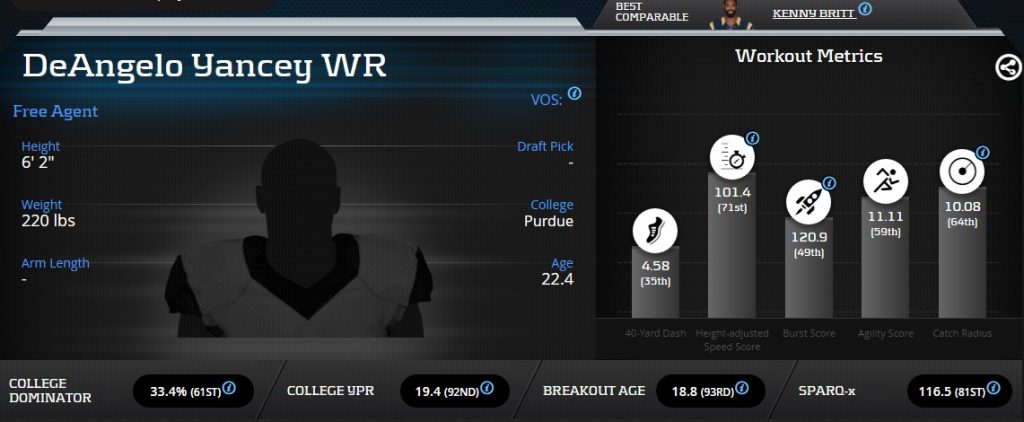Height: 6-2
Weight: 220
Age: 22.2
40-Yard Dash: 4.58 (35th percentile)
Height-adjusted Speed Score: 101.4 (72nd percentile)
Burst Score: 120.9 (49th percentile)
Agility Score: 11.11 (60th percentile)
Catch Radius: 10.08 (64th percentile)
Best Comparable: Kenny Britt
DeAngelo Yancey‘s best year was in 2016 as a senior where he caught 951 receiving yards and 10 touchdowns on 49 receptions; accounting for 40-percent of Purdue’s total receiving touchdowns. There are serval issues with his profile including declaring for the NFL after his senior year at the age of 22 with, overall, meager production. But he could be the later round wide receiver prospect you’re looking for in a dynasty league.
Yung Jabba Du Hut took the time to put this year’s wide receiver prospects through Kevin Cole’s WR Prospect Regression Tree recently. DeAngelo Yancey came in 7th, in a group of prospects with a 50% chance of success in the NFL.
At 6-2 with a 220-pound frame, a 10.08 (64th-percentile) Catch Radius and a 101.4 (72nd-percentile) Height Adjusted Speed Score, it’s easy to like the metrics and start drawing some comparisons. DeAngelo Yancey‘s final year of production is similar to JuJu Smith-Schuster‘s final year (914, 10 touchdowns on 70 receptions). They share a Breakout Age in the 93rd-percentile, and Yancey posted a higher 33.4-percent (61st-percentile) College Dominator Rating in his final season at Purdue.
We should temper excitement about the JuJu Smith-Schuster comparison. Smith-Schuster remains a much more impressive prospect. He declared as a Junior and had a 2015 season that dwarfs anything DeAngelo Yancey ever did in college with over 1400 receiving yards. Juju’s best comparable player is DeAndre Hopkins. Yancey’s is Kenny Britt. Britt truthers can balk at the comparison as well. Britt was a lot more prolific in college and declared for the NFL draft as a Junior. Juju is a lot more likely to enjoy a successful NFL career while Yancey may simmer as a promise, never realized. Still, the similarities in the metrics are intriguing.
The differences in production between DeAngelo Yancey and more impressive prospects comes with a significant difference in situation. Yancey played at Purdue, a team that has won a total of nine games since he joined in 2013. Even then, Yancey immediately made himself useful in the passing game and was a large part of any success Purdue had.
In his first year, as a part-time player, DeAngelo Yancey managed 546 receiving yards and 2 touchdowns on 32 receptions. In 2014 he dropped to 147 receiving yards and 3 touchdowns. But his reception total also dropped to 12 and Purdue increased their rushing touchdowns from 6 the previous year to 17 in 2014. Akeem Hunt subsequently went undrafted and now lives somewhere on Houston’s depth chart. It is concerning that the team still managed 16 receiving touchdowns and Yancey only caught 3 of them, but that was the second-highest number on the team and the highest total was 4. He was also still only a part time player. In 2015 he became the team’s leading receiver and managed 700 receiving yards and 5 touchdowns on 48 receptions; accounting for 27.7-percent of all Purdue’s receiving touchdowns for the year.
DeAngelo Yancey’s muted his college production, combined with an interesting athletic profile, makes him a possible late round addition to a dynasty team with a deep roster or taxi squad. Ultimately, Yancey’s most likely projection is the worst of what we have already seen from the promise of Kenny Britt. But a promise is a promise.



